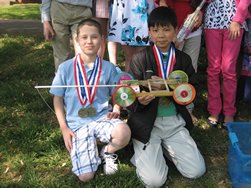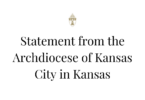
Sixth-graders AJ Brady and Minh Nguyen show off their mousetrap vehicle, which won first place at the Science Olympiad in Wichita.
A point about science and funding was made in the movie “The Right Stuff.” No bucks = no Buck Rogers. That didn’t stop some Catholic school kids from bucking the paradigm on a shoestring budget.
by Sheila Myers
Mad scientists? Not at John Paul II School in Overland Park. The school’s Science Olympiad team is pretty happy.
The team of 15 sixth-, seventh- and eighth-graders, led by science teacher Mary Anne Brown, brought home six medals from the Olympiad state tournament April 7 in Wichita.
The results were impressive for a relatively small school on a shoestring budget. At the state level, teams compete in either the small or large school division.
“Our middle school enrollment is 66,” Brown said. “Only two of the 17 small schools had lower enrollments.”
John Paul principal Susie English credits the team’s success to the student’s dedication, parental support and Brown’s teaching ability.
“Mrs. Brown is a phenomenal teacher, and she has always had good luck with the Science Olympiad,” said English.
Parents from all 15 families gave up part of their Easter weekend to attend the tournament at Wichita State University with their children. The families even attended Holy Saturday services together.
The team’s winning formula of camaraderie plus a sincere interest in science resulted in three first-place, one second- and two third-place medals.
“We have no budget,” Brown said. “It’s just me. [The students] do mostly independent work. They come after school on their free time.”
Problem solving is key
The Kansas Science Olympiad website says the point of Science Olympiad is to learn some science and have some fun in the process.
Students work in teams of two on events representing different science disciplines: biology, physics, chemistry, earth science and engineering. For the events, students answer questions, perform lab experiments and build a structure or robot.
One would think that watching science experiments is not the stuff of high drama, but Science Olympiad is infused with nail-biting tension, as eighth-graders Shannon Sutherlin and Emily O’Meara discovered.
The trouble started when one of two wells the girls constructed for Amazing Aquifers, an event to increase understanding of groundwater concepts, did not work.
“Then our ink, which we use to show contamination, leaked everywhere in our container,” Shannon said. “It was black food coloring.”
Shannon and Emily kept their cool during the timed event. They washed out their containers and substituted red food coloring.
Their quick thinking paid off. They won second place.
That kind of think-on-your-feet problem solving is what makes Science Olympiad such a valuable experience for the students.
“The event enhances critical thinking, higher level thinking, and it excites the kids,” said English. “They compete against other schools. They build things on their own. They understand the whole process and how they get there.”
Making the cut
Brown, a science teacher since 1987, initiated Science Olympiad as an extra-curricular activity at John Paul II when she started teaching at the school in 2005. The club meets three times a week during the school year. Students spend their Science
Olympiad meetings doing research and performing experiments.
Brown selects the team in December. Students practice for events at invitational and regional competitions. The best performing teams are invited to state.
This year, 22 students tried out for 15 spots. The club is so popular that students who don’t make the team continue to participate in the club. Such is the case for sixth-grader Emily Matos.
“I go because it’s interesting to see what they do. And maybe next year, I can officially get onto [the team],” she said.
Brown has developed a point system to determine who makes the team.
“I look for kids who can work independently, responsibly, work with each other and focus on what’s important,” she said.
Independent problem solving is such an important aspect of Science Olympiad that events are cordoned off to keep teachers and parents from interfering.
But sometimes, well-meaning adults get in the way. During a regional competition in February, sixth-graders AJ Brady and Minh Nguyen were setting up their catapult for the Storm the Castle event.
“I was standing there with another dad, and AJ had his back to us,” Brown said. “We were telling him, ‘It’s crooked. Straighten it out.’ And I could see his back stiffen. He was not going to listen to us.
“And darn if the thing didn’t go straight in [the target]. He knew exactly what he was doing.”
Superintendent Kathy O’Hara said Brown is an example of the creative, dedicated teachers at Catholic schools who inspire students to learn — teachers who are “on fire” with being able to share with students the beauty of God’s universe.
But Brown heaps the praise on her crop of bright, young scientists, many of whom hope to pursue a science-related career.
“They don’t need me,” she said. “This is an awesome group. They all work together. I think they learn better from each other than they would from me.”






